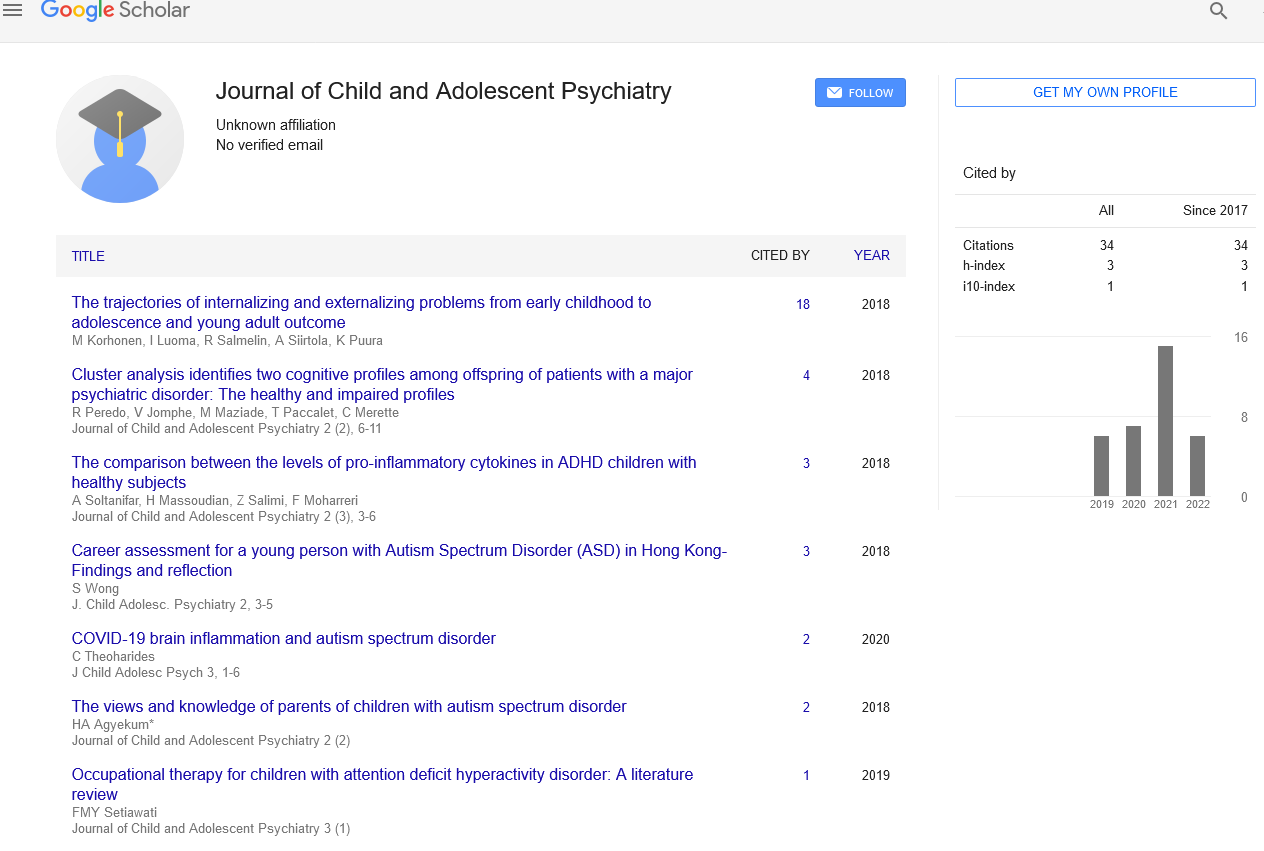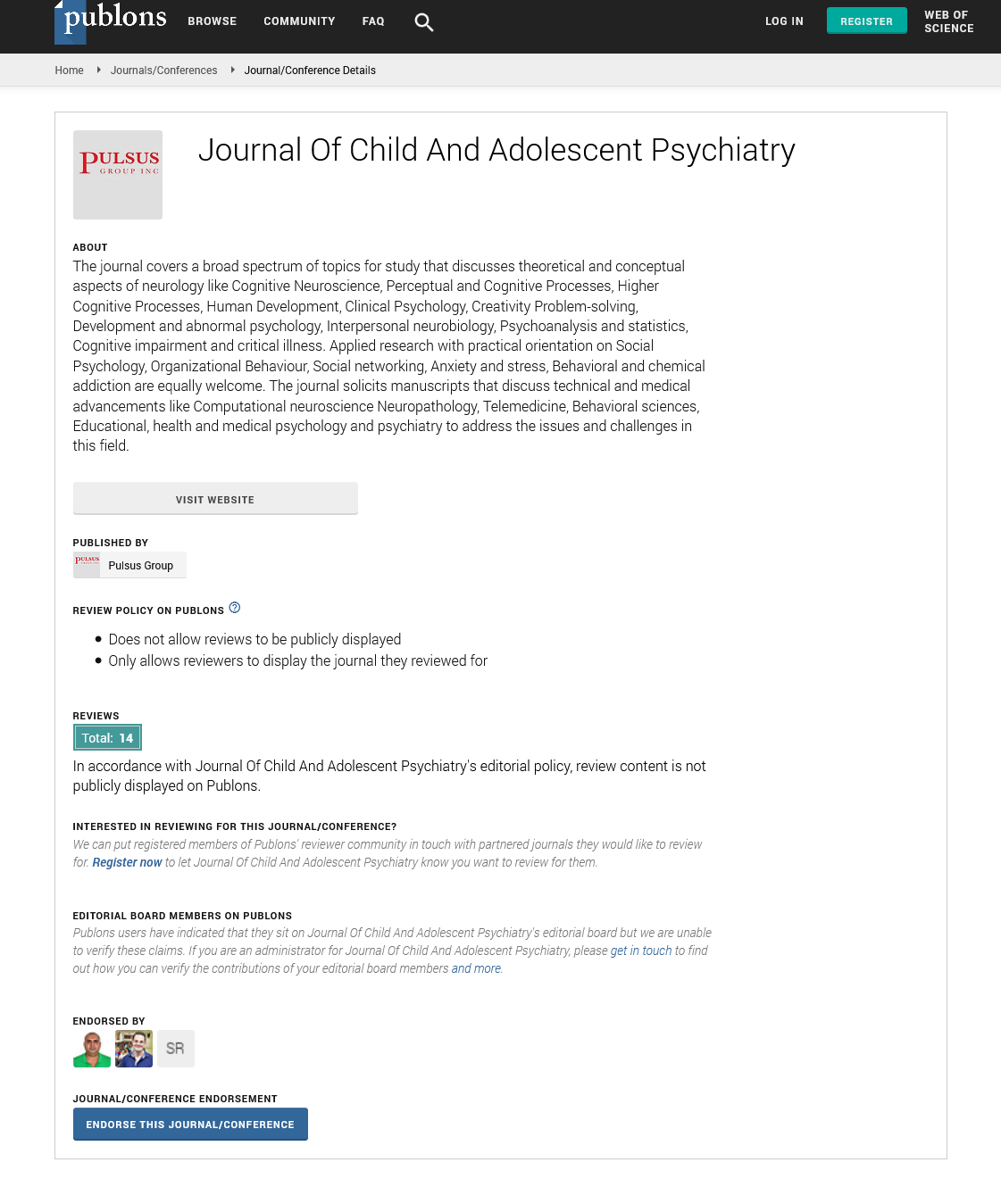Radicalization among adolescents
Received: 21-Dec-2021, Manuscript No. PULJACP-22- 4853; Editor assigned: 23-Dec-2021, Pre QC No. PULJACP-22- 4853; Accepted Date: Jan 07, 2022; Reviewed: 27-Dec-2021 QC No. PULJACP-22- 4853; Revised: 03-Jan-2022, Manuscript No. PULJACP-22- 4853(R; Published: 13-Jan-2022, DOI: 10.37532/puljacp.2022. 6(1)-11-12
This open-access article is distributed under the terms of the Creative Commons Attribution Non-Commercial License (CC BY-NC) (http://creativecommons.org/licenses/by-nc/4.0/), which permits reuse, distribution and reproduction of the article, provided that the original work is properly cited and the reuse is restricted to noncommercial purposes. For commercial reuse, contact reprints@pulsus.com
Abstract
Recent research have proven better costs of radicalization of children than with inside the 2000s. Since 2015, radicalization prevention devices were applied in baby and adolescent psychiatry departments in France. We aimed to document at the psychopathology of children who have been observed up in a college branch because of their “radical behavior”. Based at the to be had scientific statistics (from baby psychiatry consultations, long-time period owns circle of relatives and/or person therapy, and mental testing) for 20 children with “radical behavior,” we tested the character in their radical behavior, their psychopathology, their own circle of relatives characteristics, and the lifestyles or absence of worrying experiences. Among the 20 children, four had radical behavior related to a delusional syndrome (schizophrenia or a psychotic episode after substance abuse). For the opposite 16, we located no psychotic conditions. The evaluation of different statistics confirmed that the child- -ren shared a few characteristics, together with a vital incidence of intrafamilial violence, sexual abuse, imprisonment of own circle of relatives members, worrying own circle of relatives histories, and enormous mental manipulate or dependence phenomena taking place in divided families. This variety of psychopathologies seems constant with preceding research highlighting the relevance of various profiles relying at the presence of a delusional syndrome, the person`s gender and the person's enchantment to violence. Finally, we talk a few psychopathological hypotheses and make healing recommendations. We consider that baby and adolescent psychotherapy/psychiatry has a function to play in countering violent extremism via way of means of These capacities are reflected in the progressions happening in the cerebrum. We realize that the region of the cerebrum affected by getting others and anticipating their activities are going through changes during immaturity. Thus, this may be a period when we are additional delicate to signals from individuals around us and the occasions in our public activities.
Keywords
Radicalization; Psychiatric disorder; Psychopathology
Introduction
Terrorism and radicalization have primarily been studied with the aid of using researchers in political science, sociology, and criminology with inside the beyond decades. This studies have been performed primarily in reaction to security, political, and judicial needs. The subject of social psychology has additionally made sizable advances with the aid of using reading organization dynamics and the ability blessings for a man or woman who joins a violent extremist organization. Over the final decade, the variety of psychology and psychiatry research has increased; those research have attempted to painting the mental traits of people engaged in violent extremism. Two essential problems have emerged from the findings: hyperlinks among intellectual fitness and radicalization and the hyperlinks among mental traits and the trajectories of radicalized people. There is a consensus a number of the majority of teachers concerning the hyperlinks among intellectual fitness and radicalization. The variability of what's certified as “intellectual infection” and “radicalization” in specific research has ended in reviews of heterogeneous incidence charges of radicalization amongst people with intellectual infection, starting from zero to 57%. By intently analyzing the to be had records with inside the literature, anticipated that the maximum correct price of radicalization for people with a showed prognosis is 14.4%. Several research has made a few distinctions, ensuing with inside the elaboration of categorizations or profiles. First, Merari prominent among “suicide bombers” and “organizers” of suicide attacks. By evaluating organizers and applicants for a suicide attack, he confirmed that the latter had an extensively decrease stage of self-esteem, showing greater signs of despair and a greater structured and avoidant personality. This mental profile made people greater amenable to organization, leader, and public influence. Several research has additionally shed mild on intellectual fitness problems being greater not unusual place for lone actor terrorists. Lone actor terrorists had been discovered to showcase greater intellectual fitness troubles than terrorists who acted in a set and to have relationships with a violent extremist organization member however to now no longer clearly belong to the organization. However, the related elements and trajectories of people worried in radicalization and terrorism in Western societies rely on the neighborhood context. Over the final decade, many younger human beings in Europe have subscribed to the ideology of the Islamic State. They have proven their adherence in specific ways: traveling to participate with inside the Iraqi-Syrian armed conflict, spreading the movement`s underlying ideas, and taking part in violent attacks. Unlike Al-Qaeda's terrorism with inside the 2000s, this radicalization has been an endogenous phenomenon in that younger people have grew to become in opposition to the surroundings wherein they grew up. Data suggest 3 new traits with inside the radicalization phenomenon in Europe: in comparison to topics who joined Al-Qaeda with inside the 2000s, the latest radicalized topics encompass greater children, greater women, and greater latest converts to Islam. Several scientists have defined those observations primarily based totally on societal changes, organizational shifts in jihadist companies, and the developing presence and recruitment pastime of such companies at the internet. These latest findings on young people radicalization have ended in new strategies of prevention. These strategies encompass secondary prevention (directed at people recognized as being prone to radicalization) and tertiary prevention (directed at people who've deliberate or devoted a violent extremist act). Educational, mental, and psychiatric programmes have posted outcomes highlighting the specificities of those strategies. A longitudinal have a look at discovered that a worse repute at follow-up (nonetheless being radicalized or having reached the Islamic State) turned into related to neighborhood/proximal phenomena (having tried to radicalize different loved ones and having a near pal or relative imprisoned earlier than radicalization. A assessment of minors vs. adults established that minors offered greater self-damage records earlier than radicalization, fewer tries to radicalize their environment and peers, fewer instances of radicalization amongst their environment and peers, and much less radicalization thru assembly in person. Looking deeper at motivational dimensions, researchers additionally observed that a few girl topics had a selected affective motivation (searching out an idealistic, spiritual guy to marry). Additionally, male topics reporting violent tendencies, hobby in weapons, adventure, combating (“male values”), loss of self-esteem, or a loss of hobby in looking for affection skilled extensively worse outcomes. Another have a look at that targeted on imprisoned adults interested by violent extremism installed four profiles: “bold offenders,” “crook community converts,” “human beings in precarious situations,” and “folks who are critically mentally ill.” Individuals withinside the “critically mentally ill” profile represented 10.7% of the pattern and had an average age of 34 years, which turned into extraordinarily older than the imply age of the pattern with inside the formerly cited have a look at (imply age=23.32 years). Overall, primarily based totally on those research, we hypothesized essential trajectories amongst European children and teenagers worried in radicalization.
- Those who radicalized themselves in a neighborhood/proximal context and had been attracted to violence and combating.
- More youthful those who offered with greater mental vulnerabilities (self-damage records). In this 2nd trajectory, we observed a higher reaction to de radicalization programmes and, for females, an affective motivational dimension.
Nevertheless, intellectual infection in line with se does now no longer appear to be found in children and teenagers, at the same time as it seems to be greater common in adults. From a greater scientific and psychopathological angle, psychiatrists and psychologists who've cared for children and teenagers have attempted to give an explanation for adherence to violent ideologies. Adolescence has been underlined as a length whilst young people are liable to radicalization. The significance of own circle of relatives dynamics has additionally been cited. One of the primary hypotheses is that radicalized children or teenagers enjoy mental manage with the aid of using their dad and mom with inside the own circle of relatives organization and, paradoxically, expand a comparable dating with the novel organization: they undo the own circle of relatives's mental manage to recreate it with a set that considers them adults. The essential issue that we are facing as care specialists is that quantitative and qualitative research do now no longer mesh properly together. On the only hand, worldwide outcomes offer partial symptoms approximately intellectual infection in precise samples, and on the opposite hand, case research describe distinct






